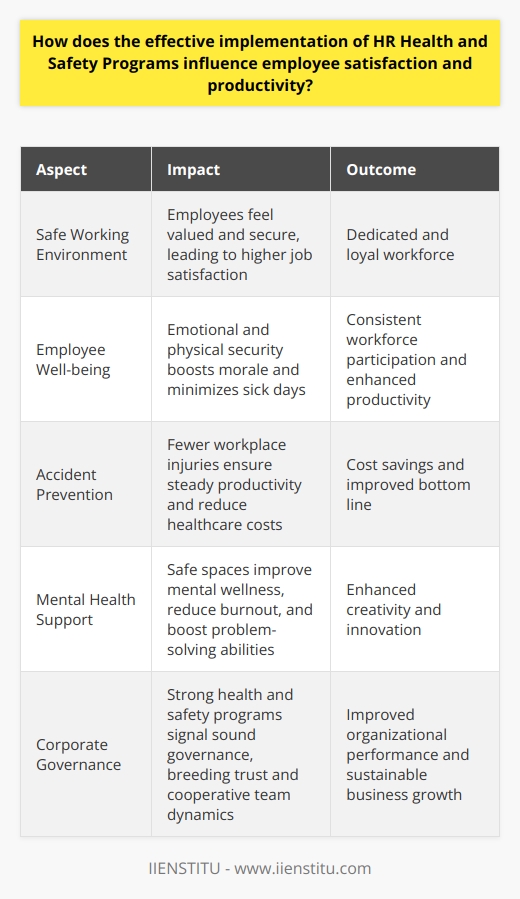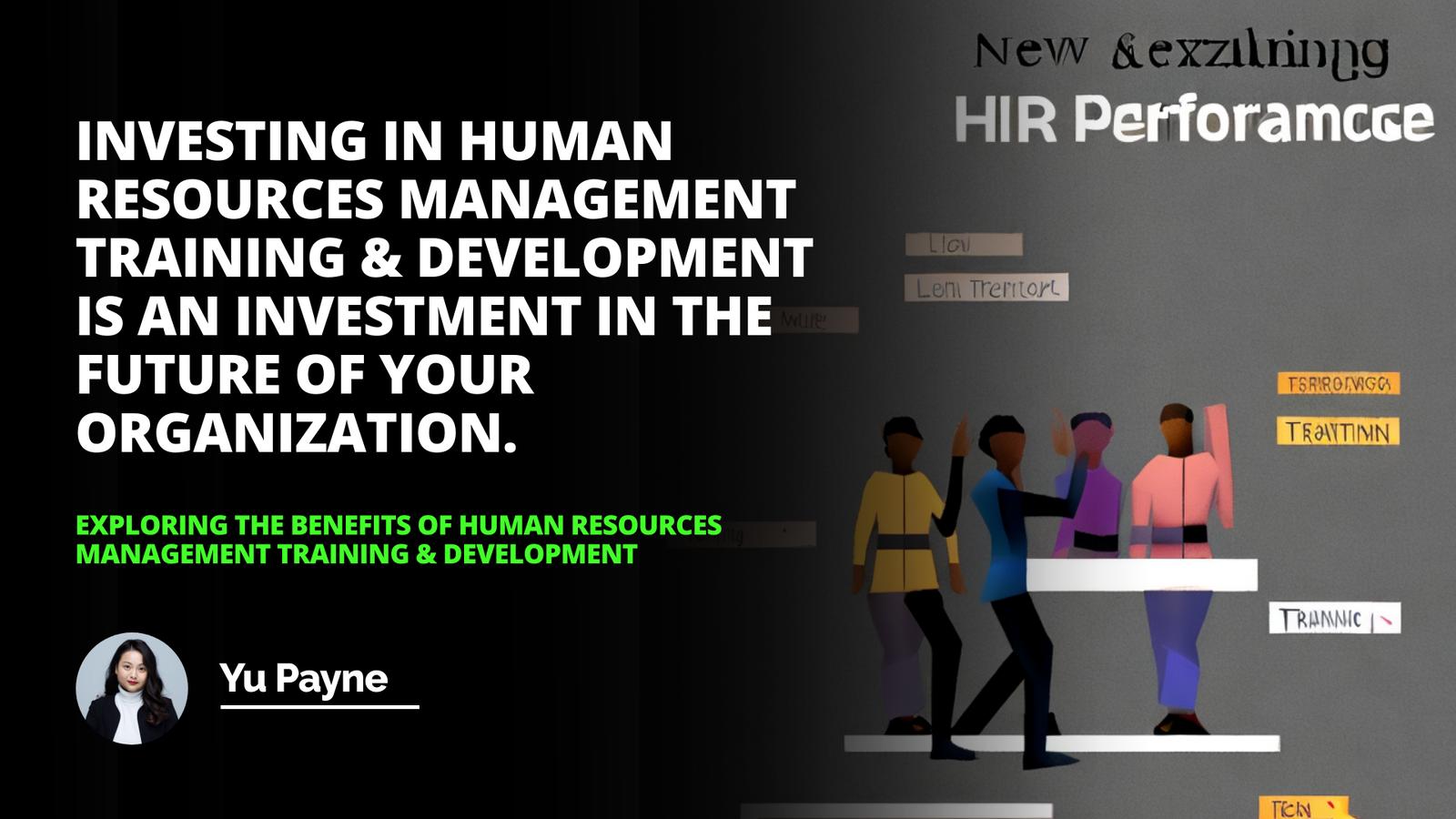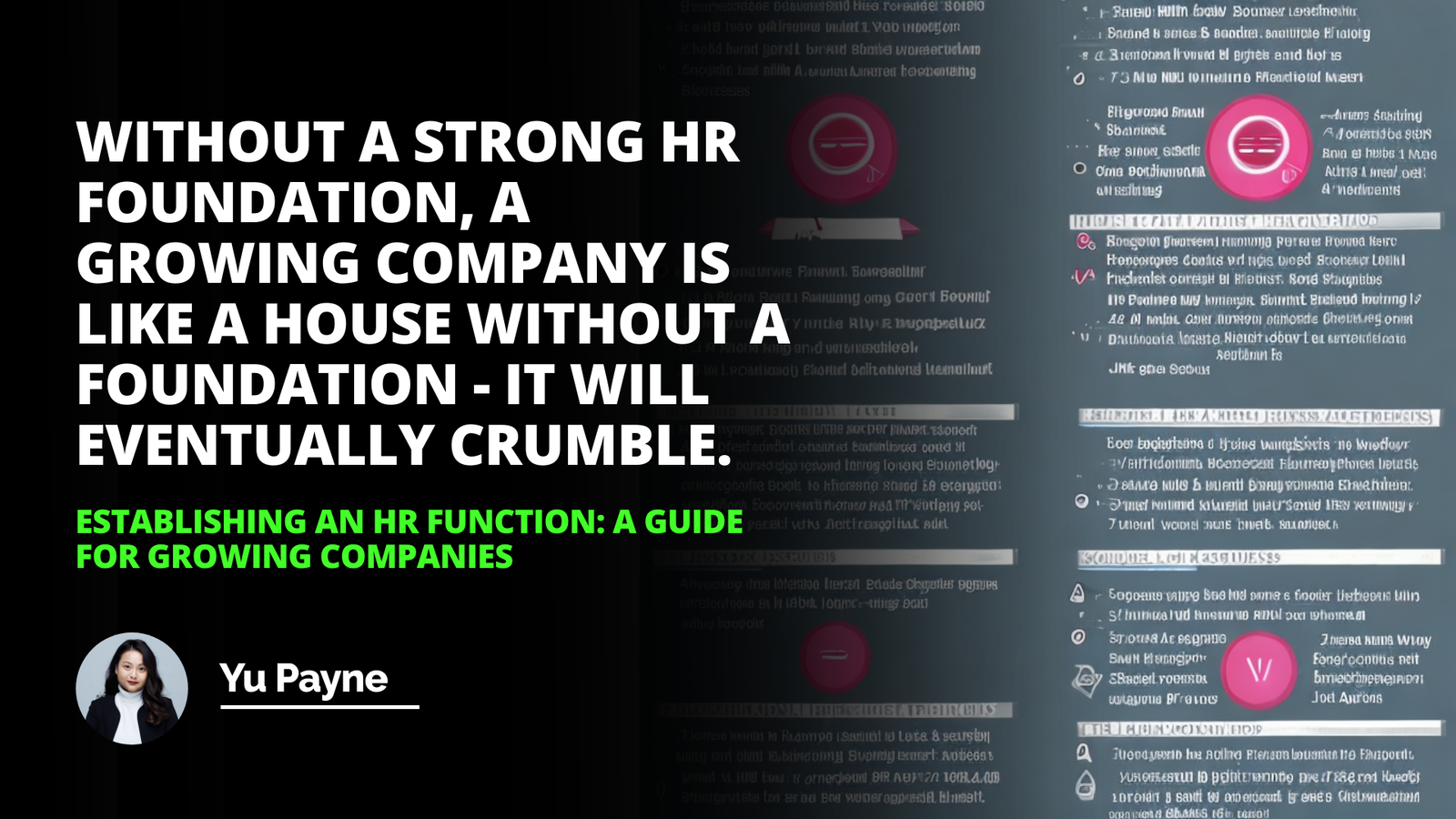
I still remember the day when one of my colleagues slipped in the office corridor and fractured his arm. It was a wake-up call for all of us about the importance of workplace safety. As someone who has spent over a decade in Human Resources, I've come to realize that HR health and safety programs are not just bureaucratic necessities—they are vital lifelines that ensure the well-being of every employee.
The Crucial Role of HR in Health and Safety
Understanding the Heart of Health and Safety Programs
Health and safety programs are more than just policies on paper; they're commitments that organizations make to protect their most valuable assets—their employees. These programs aim to identify potential workplace hazards, implement preventive measures, and cultivate a culture where safety is everyone's responsibility.
I recall attending a seminar where the speaker quoted from "The Safety Anarchist" by Sidney Dekker: "Safety is not the absence of accidents, but the presence of defenses." This resonated with me deeply, emphasizing that proactive measures are essential in preventing incidents before they occur.
HR as the Guardian of Workplace Well-being
In my experience, HR professionals are the unsung heroes in maintaining and implementing these programs. We are the bridge between the management's vision and the employees' daily realities. By conducting regular risk assessments and facilitating employee training, HR ensures that safety protocols are not only established but also embraced by everyone.
I once led an initiative to introduce ergonomic workstations after noticing a rise in employee complaints about back pain. This not only improved comfort but also boosted productivity—a win-win situation that underscored the impact of thoughtful HR interventions.
Key Components of Effective HR Health and Safety Programs
Workplace Hazard Assessment: The First Line of Defense
Identifying potential risks is the cornerstone of any safety program. HR must collaborate with various departments to conduct thorough workplace hazard assessments. This involves:
Regular Inspections: Scheduling routine checks to spot and rectify hazards.
Employee Feedback: Encouraging staff to report unsafe conditions without fear of reprisal.
Data Analysis: Reviewing incident reports to identify patterns and areas for improvement.
I remember reading in "Risk Management in Organizations" by Margaret Woods that "effective hazard assessment is as much about listening as it is about observing." This highlights the importance of open communication channels within the workplace.
Employee Training: Empowering Through Knowledge
Knowledge is power, especially when it comes to safety. HR should design comprehensive training programs that cover:
Emergency Procedures: Clear guidelines on what to do in case of fires, earthquakes, or other emergencies.
Equipment Usage: Proper operation instructions to prevent mishaps.
Health Protocols: Information on maintaining personal health, including stress management and ergonomic practices.
After implementing a series of safety workshops in my previous company, we saw a 30% reduction in workplace accidents. Employees felt more confident and aware, which translated into a safer working environment.
Wellness Programs: Beyond Physical Safety
Health and safety extend beyond preventing accidents. Wellness programs address the overall well-being of employees, including mental and emotional health. These initiatives can include:
Fitness Memberships: Offering gym discounts or on-site fitness classes.
Mental Health Support: Providing access to counseling services or stress-relief activities.
Work-Life Balance: Promoting flexible working hours or remote work options.
In "The Wellness Revolution" by Paul Zane Pilzer, it's stated that "investing in employee wellness yields returns in productivity, morale, and overall company performance." I've witnessed this firsthand when our company introduced mindfulness sessions, leading to a noticeable improvement in employee satisfaction.
Legal and Ethical Foundations
Navigating OSHA Compliance
Compliance with regulations like the Occupational Safety and Health Act (OSHA) is non-negotiable. HR must stay updated on legal requirements to avoid penalties and, more importantly, to ensure employee safety.
Key steps include:
Policy Updates: Regularly revising safety policies to align with current laws.
Documentation: Keeping detailed records of all safety measures and incidents.
Training Compliance: Ensuring that all employees complete mandatory safety training.
I recall a case where a company faced hefty fines due to lapses in OSHA compliance. It was a stark reminder of the importance of diligent adherence to legal standards.
Upholding Ethical Responsibilities
Beyond legal obligations, there's an ethical duty to care for employees. This means fostering an environment where safety concerns are addressed promptly and transparently.
Open Dialogue: Encouraging employees to voice concerns without fear.
Fair Treatment: Ensuring all staff have equal access to safety resources.
Responsiveness: Acting swiftly to rectify identified issues.
As highlighted in "Ethics in Human Resource Management" by John R. Deckop, "ethical practices in HR not only build trust but also enhance the organization's reputation." This trust is the foundation of a strong safety culture.
Continuous Improvement: Evaluating and Enhancing Programs
Tools for Measuring Effectiveness
To ensure that health and safety programs remain effective, regular evaluation is essential. HR can utilize:
Surveys and Feedback Forms: Gauging employee perceptions and suggestions.
Incident Tracking Software: Monitoring and analyzing workplace accidents.
Benchmarking: Comparing performance against industry standards.
After implementing an anonymous feedback system, our team uncovered issues we hadn't anticipated, allowing us to make targeted improvements.
Strategies for Ongoing Enhancement
Stagnation is the enemy of progress. HR should strive for continuous improvement by:
Staying Informed: Keeping abreast of the latest safety technologies and practices.
Employee Involvement: Including staff in the development of safety initiatives.
Learning from Others: Adopting best practices from organizations recognized for safety excellence.
In "The Learning Organization" by Peter Senge, it's emphasized that "organizations that excel will be those that discover how to tap people's commitment and capacity to learn." This is particularly true for health and safety.
Fostering a Culture of Safety: My Reflections
Looking back, the journey toward effective HR health and safety programs is continuous and evolving. It's about more than policies—it's about people. Each initiative we undertake has the potential to make a significant difference in someone's life.
I encourage my fellow HR professionals to:
Be Proactive: Don't wait for incidents to occur before taking action.
Show Empathy: Understand the human element behind every policy and procedure.
Seek Collaboration: Work closely with all departments to create a unified approach.
Offering Support and Moving Forward
If you're looking to enhance your organization's health and safety programs, numerous resources are available:
Professional Workshops: Attend seminars and training sessions.
Online Courses: Enroll in HR certificate programs focusing on occupational safety.
Consult Industry Experts: Seek advice from professionals with a proven track record.
Remember, the goal is to create a workplace where everyone feels safe and valued. It's a challenging endeavor but one that is incredibly rewarding.
Final Thoughts
Embracing robust HR health and safety programs is not just about compliance—it's about caring for our colleagues and fostering an environment where everyone can thrive. By sharing experiences, learning continuously, and committing to ethical practices, we can navigate the complexities of workplace safety together.
As Maya Angelou once said, "People will forget what you said, people will forget what you did, but people will never forget how you made them feel." Let's make our employees feel safe, respected, and valued every day.
Frequently Asked Questions
What are the key components of a successful HR Health and Safety Program and how do these contribute to overall organizational efficiency?
Introduction
Health and Safety (H&S) programs are crucial in all workplaces. They ensure employee well-being. Moreover, they enhance operational effectiveness. This article outlines the critical components of successful H&S programs and their role in promoting organizational efficiency.
Comprehensive Policy Development
Policy development stands as the foundation. Clear guidelines and precise rules define a H&S program.
Employee Engagement
Employee participation is essential. Workers provide practical insights. They suggest feasible improvements. This involvement often leads to broader acceptance. Engaged employees strive for a safer workplace.
Leadership Commitment
Leaders must show unwavering support for H&S initiatives. Their action reflects organizational commitment. Employees model this behavior and uphold safety standards.
Regular Training and Education
Continuous education maintains program vigor. Workers learn about potential hazards. They stay informed about preventive measures. Regular training sessions lead to a competent workforce.
Effective Communication
Communication bridges gaps between policy and practice. Simple, regular messages keep staff aware. Engagement in safety discussions empowers everyone.
Risk Assessment and Management
Identifying risks is pivotal. Effective management requires thorough risk assessment. Early hazard recognition prevents accidents. It facilitates swift response planning.
Continuous Improvement
Innovation fuels improvement. Feedback mechanisms lead to better practices. Adapting to new challenges keeps a program relevant.
Emergency Preparedness
Plans for potential emergencies save lives. Employees must know their roles. Drills and simulations build confidence. This readiness minimizes potential harm during actual events.
Health and Safety Culture
A strong culture underpins program success. It influences employee attitudes and behaviors. A culture centered around safety creates a resilient organization.
Monitoring and Reporting
Accurate records are crucial. Data drives decision-making. Continuous monitoring uncovers trends. Reporting mechanisms enhance transparency. They ensure accountability within the organization.
Access to Health Resources
Employees should have health support access. This encourages wellness. It mitigates long-term health issues.
Conclusion
A robust H&S program is multifaceted. It harmonizes policies, people, and practices. Together, these components forge an efficient, safe workplace. Organizational efficiency stems from a healthy, secure workforce.

How does the effective implementation of HR Health and Safety Programs influence employee satisfaction and productivity?
The Link between HR Health and Safety Programs and Employee Satisfaction
Effective HR health and safety programs are crucial. They ensure a safe working environment. Employee well-being remains the priority. When safety measures are robust, workers feel valued. Confidence in company care translates to higher satisfaction. Such programs reflect organizational commitment to staff welfare.
Employees seek more than paychecks. They want safety and health protection too. Emotional and physical security boosts morale. Satisfaction then follows, nurturing a dedicated workforce. When employees feel secure, they invest more effort. They show greater allegiance to their employer's cause.
Productivity: A Result of Enhanced Safety Measures
Safe environments empower employees. They allow focus on tasks, not hazards. Fewer accidents mean consistent workforce participation. Regular participation enhances experience and skill. With more practice, productivity invariably rises.
Health programs foster disease prevention. They minimize sick days. Robust safety systems reduce workplace injuries. Both ensure steady productivity.
Mental health is equally critical. Safe spaces improve mental wellness. Better mental health means less burnout. Less stress boosts problem-solving abilities. Creativity often flourishes under these conditions.
The Ripple Effect of Health and Safety on Organizational Performance
Safety programs signal strong corporate governance. Sound governance breeds trust. Trust encourages cooperative team dynamics. Such dynamics enhance organizational performance.
* High employee satisfaction reduces turnover rates.
* Reduced turnover saves recruitment and training costs.
* Lower costs coupled with higher productivity bolster profits.
In this way, health and safety programs can directly affect a company's bottom line. They are not mere compliance tools. They are strategic instruments for sustainable business growth.
Final Thoughts on Health, Safety, and Productivity
Effective health and safety plans are non-negotiable. They influence multiple layers of business success. These layers stretch from individual well-being to collective productivity. They extend further to overall company performance.
Implementing these programs is a testament to corporate responsibility. It is an investment in human capital. This investment pays dividends in employee satisfaction and efficiency.
For businesses aiming for longevity, focusing on health and safety is wise. Healthy workers are happy workers. Happy workers are productive. This productivity fuels business success. Health and safety programs are thus not only ethical. They are smart economics.

What challenges are commonly faced in the implementation of HR Health and Safety Programs and how can these be adequately addressed?
Implementing HR Health and Safety Programs
Common Challenges
Resistance from Employees
Implementing health and safety programs often meets employee resistance. Changes disrupt routines. Employees may fear increased workload. Familiar processes seem easier. Communication strategies can reduce resistance. Use clear, frequent communication methods. Address concerns empathically. Leverage change champions among staff.
Lack of Training
Leaders and employees frequently lack proper training. Training gaps affect program adoption. Address this with comprehensive training sessions. Invest in continuous learning opportunities. Customize training to diverse learning styles.
Cost Constraints
Budget restrictions pose significant hurdles. Health and safety are often underfunded. Prioritize spending on critical safety measures. Seek management buy-in on cost benefits. Explore cost-effective training solutions.
Regulatory Compliance
Laws and regulations constantly evolve. Staying compliant is challenging. Regularly update your knowledge base. Seek expertise from legal professionals. Implement compliance as an ongoing process.
Data Management
Accurate data management is vital. Poor data leads to ineffective decisions. Establish meticulous record-keeping procedures. Invest in robust data management systems. Train staff on proper data handling.
Addressing the Challenges
Engaging Leadership Commitment
Without leadership support, programs flounder. Engage leaders at all levels. Demonstrate the benefits of health and safety. Use data to support your case.
Cultivating a Safety Culture
A safety-first mindset must prevail. Involve everyone in safety initiatives. Celebrate safety achievements publicly. Make safety an integral company value.
Providing Adequate Resources
Successful programs require resources. Secure necessary funding and tools. Do not compromise on safety investments. Allocate resources smartly.
Regular Evaluation and Feedback
Continuous improvement drives success. Evaluate programs systematically. Seek feedback from all levels. Adjust strategies based on feedback.
Innovative Solutions and Technology
Embrace modern technologies. They streamline safety processes. Modern solutions can enhance training. Use technology to automate compliance checks.
In Summary
Health and safety implementation has its challenges. Address these proactively and systematically. Sustain efforts through constant engagement. Ensure resources and align with company culture. Regular evaluation and adaptation are key. Use technology as a helpful ally. With these practices, HR can effectively implement health and safety programs that safeguard workers and contribute to a resilient organizational environment.



